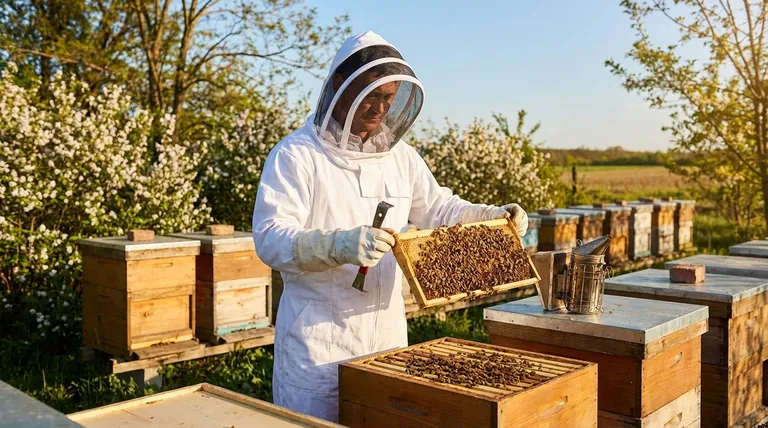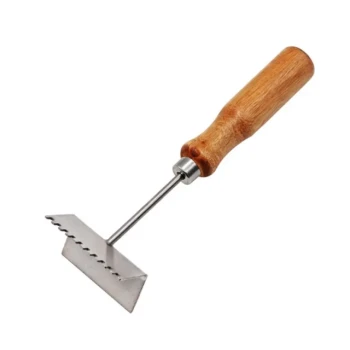At its core, the purpose of beekeeping protective clothing is to serve as the first and most critical line of defense against bee stings. This specialized gear creates a physical barrier between you and the bees, allowing you to work safely and confidently. It transforms beekeeping from a potentially painful activity into a focused and enjoyable practice.
Protective gear is not just about avoiding stings; it's about enabling the calm, deliberate state of mind required for effective hive management. Safety fosters confidence, which in turn leads to better beekeeping.

The Core Function: A Barrier Against Stings
Protective clothing is the single most important tool for ensuring a beekeeper's personal safety. Its design is based on understanding bee behavior and creating a simple, effective shield.
Why Bees Sting
Bees are not inherently aggressive; they sting as a defensive response. When a colony perceives a threat to its hive, queen, or food stores, guard bees will act to neutralize that threat.
How Protective Gear Works
Beekeeping suits, jackets, and veils are made from smooth, thick fabric that is difficult for a bee's stinger to penetrate. The veil is the most critical component, as it uses a fine mesh to shield the sensitive face and eyes while maintaining visibility.
Beyond Pain Prevention
By removing the immediate threat of stings, protective gear allows you to focus on the task at hand. You can inspect frames, check for hive health, and manage your colonies without the distraction of flinching from every bee that flies near you.
Maintaining a Clean Environment
This gear also serves a secondary purpose of promoting apiary hygiene. It helps prevent contaminants or dirt from your regular clothes from being introduced into the highly sensitive hive environment.
Key Components of a Protective System
A complete protective system consists of several integrated parts, each designed to shield a different area of the body. Beekeepers can mix and match components based on their comfort level and the temperament of their bees.
The Veil: Essential Facial Protection
The veil is non-negotiable. It protects your face, neck, and eyes, areas where a sting can be particularly painful and dangerous. Most modern veils are integrated into a jacket or a full suit for complete coverage.
The Suit or Jacket: Full Body Coverage
A full bee suit offers head-to-toe protection and is the best choice for beginners, as it leaves no gaps for bees to enter. A beekeeping jacket provides coverage for the upper body and is often preferred by experienced beekeepers for its convenience during quick inspections.
Gloves: Handling Frames with Confidence
Gloves protect your hands, which are in closest contact with the bees and frames. They are typically made from leather or thick, ventilated synthetic materials to balance protection with the need to handle equipment.
Understanding the Trade-offs
Choosing protective gear involves balancing total safety against comfort and dexterity. There is no single "best" setup; the right choice depends on your experience and specific task.
Protection vs. Dexterity
Thick leather gloves offer maximum sting protection for your hands. However, they significantly reduce your sense of touch, making it harder to handle delicate frames or the queen. Thinner nitrile gloves or even bare hands (for the very experienced) offer more dexterity at the cost of protection.
Full Suits vs. Jackets
A full suit provides comprehensive security and peace of mind. Its main drawback is that it can be hot and more cumbersome to put on and take off compared to a simple jacket and veil.
Gear Does Not Make You Invincible
It is critical to understand that no gear is 100% "sting-proof." A determined bee can sometimes find a way through a seam or stitch. The goal of protective clothing is to drastically reduce the risk, not eliminate it entirely.
Making the Right Choice for Your Goal
Your choice of protective gear should align directly with your experience level and the temperament of your bees.
- If you are a beginner: Start with a full, light-colored bee suit, veil, and gloves. This maximum protection will allow you to build confidence and learn hive dynamics without the fear of stings.
- If your primary focus is convenience for quick inspections: A jacket with an integrated veil may be sufficient, especially if you know your hives have a calm temperament.
- If you are an experienced beekeeper needing maximum dexterity: You might consider using thinner gloves or, with extreme caution, no gloves, but always wear a veil to protect your face.
Ultimately, the right protective clothing is an investment in your safety, your confidence, and your long-term success as a beekeeper.
Summary Table:
| Component | Primary Function | Key Consideration |
|---|---|---|
| Veil | Protects face, neck, and eyes from stings. | Non-negotiable for all beekeepers; maintains visibility. |
| Suit/Jacket | Creates a full or partial body barrier. | Full suit for maximum safety; jacket for convenience. |
| Gloves | Shields hands during frame handling. | Trade-off between sting protection and manual dexterity. |
Equip your apiary with confidence. HONESTBEE supplies durable, professional-grade beekeeping protective clothing and equipment to commercial apiaries and distributors through our wholesale-focused operations. Ensure the safety and productivity of your beekeeping teams with gear designed for performance. Contact HONESTBEE today to discuss your wholesale needs.
Visual Guide

Related Products
- Cotton Beekeeping Suit and Round Hat with Veil Bee Keeper Protective Gear
- 3 Layer Mesh Vented Sting Proof Beekeeping Suit with Hat and Veil
- Vented Beekeeping Jacket with Hood and Veil for Beekeepers
- Yellow Plastic Bucket Pail Perch for Beekeeping
- Long Langstroth Style Horizontal Top Bar Hive for Wholesale
People Also Ask
- Why is white the predominant color in bee suit designs? | Key to Hive Calm & Beekeeper Safety
- What is recommended for beginners in beekeeping regarding protective clothing? A Complete Safety Guide for New Beekeepers
- What are bee suits made of? Choosing the Right Material for Maximum Protection & Comfort
- Why is a jacket with a hat veil recommended for beekeepers? Essential Protection for Your Face and Neck
- How should a beekeeping suit be hung to maintain its shape? Protect Your Investment with Proper Storage



















